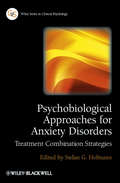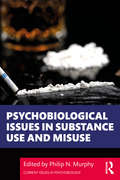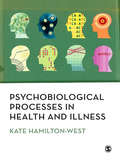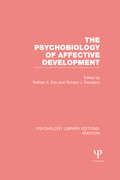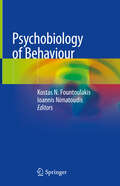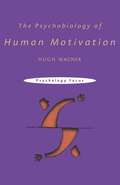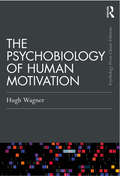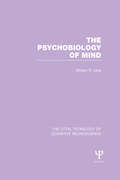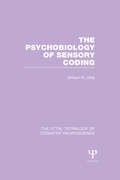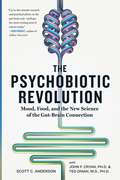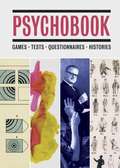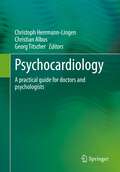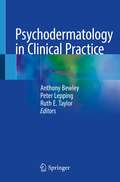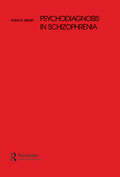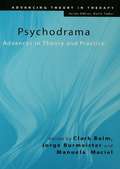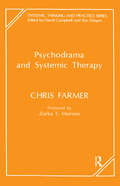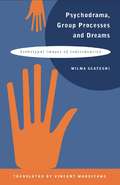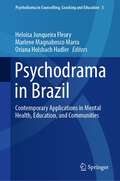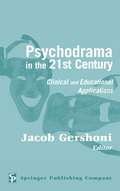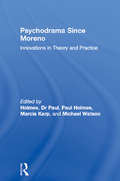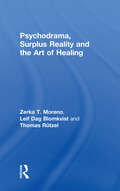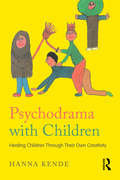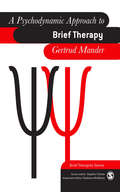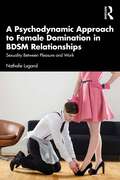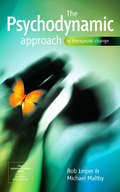- Table View
- List View
Psychobiological Approaches for Anxiety Disorders
by Stefan G. HofmannPsychobiological Approaches for Anxiety Disorders presents a comprehensive overview of the latest empirical evidence and research results on combining pharmacological agents and CBT techniques for the treatment of anxiety disorders.The first book to focus on the issue of enhancing CBT with pharmacological agents Features chapters from leading authors in the fields of psychiatry, pharmacology, clinical psychology, neuroscience, and emotion researchContributes significantly to the field by summarizing the contemporary research in combination treatments in anxiety disordersA valuable resource for clinicians in training, as well as experienced clinicians seeking to help patients with anxiety disorders
Psychobiological Issues in Substance Use and Misuse (Current Issues in Psychobiology)
by Philip N. MurphyIn this book, Murphy brings together a team of international experts to review cutting-edge scientific literature from the field of psychobiology and related disciplines which addresses important questions and broadens our understanding of substance use behaviours. The reader is introduced to the multi-faceted nature of substance use and misuse, and its growing need to be discussed across diverse disciplines and perspectives. The book also addresses important questions regarding public policy and professional practice in the context of different social and cultural environments, and comments on the methodological and ethical issues in substance use and misuse. Chapters explore a spectrum of substances, which include: cocaine, alcohol, ecstasy (MDMA), methamphetamine, synthetic cannabinoids, tobacco, ketamine, novel psychoactive substances, and vaping products. The use of these substances poses important questions for science and for society. This book is written to help academics, practitioners, and students in a variety of academic and professional disciplines answer those questions while staying up to date with the psychobiological literature. This is a vital resource for professionals and upper-level undergraduate and postgraduate students undertaking research in areas related to biological psychology, biology, health studies, and medicine.
Psychobiological Processes in Health and Illness
by Kate Hamilton-WestAn engaging introduction to the interrelationships between mind and body across a broad range of topics including infectious illness, autoimmunity, cancer and pain. Taking a biopsychosocial approach, it brings together research from a number of disciplines including health psychology, psychoneuroimmunology and behavioural genetics.<P><P> Students are encouraged to consider how advances in psychobiological research can help us to uncover the true complexity of links between psychological, biological and social processes with respect to implications for health and how such advances can inform the development of interventions and treatment.
The Psychobiology of Affective Development (Psychology Library Editions: Emotion)
by Nathan A. Fox Richard J. DavidsonOriginally published in 1984, this was the first volume on this topic to appear in an emerging area of study at the time. The editors were selective in choosing their contributions to the volume to ensure that both the developmental and neuropsychological domains were well represented. One of the major goals was to foster greater contact and cross-fertilization between subdisciplines that they firmly believed should be more intimately connected. The result is this title, which can now be enjoyed in its historical context.
Psychobiology of Behaviour
by Kostas N. Fountoulakis Ioannis NimatoudisThe book provides a comprehensive reference on the neurobiological understanding of behaviour, how behaviour is regulated by the brain, and how such behaviours in turn influence the brain. The work offers an introduction to neural systems and genetics/epigenetics, followed by detailed study of a wide range of behaviours – temperament and personality, instincts and drives, memory and cognitive function, sex and sexual differentiation, ethology and evolutionary biology, aging, drug abuse and other problematic behaviors, psychophysiology and ultimately the links to biological psychiatry and psychopharmacology. Research findings on the neural basis of social behaviour are integrated across different levels of analysis, from molecular neurobiology and neural systems/behavioural neuroscience to fMRI imaging data on human social behaviour. The content covers research on both normal and abnormal behaviours, as well as developmental aspects. The target audience includes psychiatrists, neurologists, nurses, psychologists and all researchers and advanced students in behavioural, social and developmental neuroscience, as well as clinical neuroscientists.
The Psychobiology of Human Motivation
by Hugh WagnerWhy is one person motivated to create a business empire whilst another is inspired to produce a beautiful work of art? Why do some people prefer a quiet life?The Psychobiology of Human Motivation explores what directs our behaviour, from basic physiological needs like hunger and thirst to more complex aspects of social behaviour like altruism. Hugh Wagner explores the limits of biological explanations and shows how humans can influence `basic' physiological drives in order to adapt to a complex social environment.
The Psychobiology of Human Motivation (Psychology Press & Routledge Classic Editions)
by Hugh WagnerThis is a classic edition of Hugh Wagner’s influential overview of the biopsychological underpinnings of human motivation. It includes a new foreword written by Michael Richter who reflects on Wagner’s 20 years of teaching, writing and research in the field of biopsychology and promises an engaging, succinct and accessible introductory text that remains relevant and useful to students today. The Psychobiology of Human Motivation explores what directs our behaviour, from basic physiological needs like hunger and thirst to more complex aspects of social behaviour like altruism. Wagner explores the limits of biological explanations and shows how humans can influence ‘basic’ physiological drives in order to adapt to a complex social environment. An accessible, engaging resource strengthened by many applied examples, Wagner’s text continues to be integral reading for undergraduate students seeking a solid introduction to the psychology of human motivation across the social and behavioural sciences.
The Psychobiology of Mind (The Uttal Tetralogy of Cognitive Neuroscience)
by William R. UttalOriginally published in 1978, this book develops a conceptual synthesis of the field of physiological psychology, the science specifically concerned with the relationship between the brain and the mind. It was designed to elucidate the important questions under investigation, the basic intellectual and technical problems that were encountered, and the significance of the major empirical results of the time. Of equal or even greater importance is the author’s derivation of the general principles relating brain and mind that had emerged after decades of modern research into this important question. Included in the volume are historical and philosophical perspectives on the mind-brain problem as well as extensive discussions of instruments, methodology, empirical findings and theory. Here is a powerful heuristic tool that informs the reader about the concepts and ideas implicit in this science rather than simply exhaustively listing experimental results. The author does not ignore findings; he organizes them into three broad categories – localization; representation, and learning – then emphasizes the relationships among experiments. This is a book that synthesizes, integrates, and stresses concepts, principles and problems. The careful organization of the book makes it especially useful for students of brain and mind at all levels.
The Psychobiology of Sensory Coding (The Uttal Tetralogy of Cognitive Neuroscience)
by William R. UttalOriginally published in 1973, this book deals with what were, even at that time, the well-known neural coding processes of the sensory transmission processes. The book was written to demonstrate the common features of the various senses. It concentrates on the most peripheral neural aspects of the senses starting with the physical transduction process and culminating in the arrival of signals at the brain.
The Psychobiotic Revolution: Mood, Food, and the New Science of the Gut-Brain Connection
by John F. Cryan Scott C. Anderson Ted DinanWritten by the leading researchers in the field, this information-rich guide to improving your mood explains how gut health drives psychological well-being, and how depression and anxiety can be relieved by adjusting your intestinal bacteria. This groundbreaking book explains the revolutionary new science of psychobiotics and the discovery that your brain health and state of mind are intimately connected to your microbiome, that four-pound population of microbes living inside your intestines. Leading medical researchers John F. Cryan and Ted Dinan, working with veteran journalist Scott C. Anderson, explain how common mental health problems, particularly depression and anxiety, can be improved by caring for the intestinal microbiome. Science is proving that a healthy gut means a healthy mind—and this book details the steps you can take to change your mood and improve your life by nurturing your microbiome.
Psychobook: Games, Tests, Questionnaires, Histories
by Wall Oison Lionel Shriver Mel Gooding Julian RothensteinWho knew a trip to the therapist could be so much fun, even aesthetically rewarding? Beyond sharing feelings or complaining about your mother, Psychobook reveals the rich history of psychological testing in a fascinating sideways look at classic testing methods, from word-association games to inkblots to personality tests.Psychobook includes never-before-seen content from long-hidden archives, as well as reimagined tests from contemporary artists and writers, to try out yourself, at home or at parties. A great ebook for the therapist in your life and the therapist in you, for anyone interested in the history of psychology and psychological paraphernalia, or for anyone who enjoys games and quizzes. Psychobook will brighten your day and outlook.
Psychocardiology: A practical guide for doctors and psychologists
by Christoph Herrmann-Lingen Christian Albus Georg TitscherPsychosomatic diagnostics and therapy are of increasing importance in the acute treatment, prevention and rehabilitation of cardiovascular diseases. The connection between heart disease and the psyche as well as the psychosocial concomitant symptoms is well documented. Basics of cardiology and psychosomatic medicine Doctor-patient relationship Ethical issues, gender effects, psychocardiology along the lifespan Psychosomatic problem areas and comorbidities Causes and consequences: Personality factors, risk behaviors, depression, anxiety disorders Specific diagnostics and treatment concepts - outpatient and inpatient Interdisciplinary cooperationAcute Cardiology, Heart Failure Units and Rehabilitation In accordance with German and European recommendations and guidelines, among others Position Paper on the Importance of Psychosocial Factors in Cardiology from the DGK (German Society of Cardiology) National Health Care Guideline Chronic CHD ESC Guidelines on CVD Prevention in Clinical Practice Suitable for the courses according to the curricula "Basic Psychocardiological Care" (D) and "Cardiological Psychosomatics" (A). For deepening the corresponding contents of the courses "Basic Psychosomatic Care". The book offers cardiologists, internists, general practitioners, psychotherapists and psychologists all practice-relevant basics to be able to treat their patients in the best possible way.
Psychodermatology in Clinical Practice
by Anthony Bewley Peter Lepping Ruth E. TaylorThis book represents a simple, practical resource for all healthcare professionals working with dermatological patients with psychological aspects to their disease. The emphasis is on effective guidance rather than exhaustive case reviews, providing readers with a manual on the appropriate way to approach management of the patient in each case. Comprehensive in coverage, but concise in its delivery of information, Psychodermatology in Clinical Practice presents an idealized approach to management of psychodermatology patients within a global perspective, and provides practical tools to aid assessment of patients and in the decision-making process. It is suitable for dermatologists, psychiatrists and psychologists, dermatology nursing staff, primary care physicians and pediatricians.
Psychodiagnosis in Schizophrenia
by Irving B. WeinerPsychodiagnosis in Schizophrenia is a reprint of a classic volume in assessment psychology that first appeared in 1966. The book concerns the use of psychodiagnostic techniques in the differential diagnosis of schizophrenia. The author first presents a conceptual analysis of schizophrenic disturbance in terms of impaired ego functioning and extrapolates from schizophrenic ego impairments to psychodiagnostic indices that have been demonstrated to assess them. In particular, Weiner refers to the Wechsler Adult Intelligence Scale, the Rorschach Inkblot Method, and the Draw-A-Person test. Clinical and research data delineating the nature of psychological deficits in schizophrenia are reviewed, and practical guidelines for the clinical assessment of these deficits are presented. The author next considers several differential diagnostic possibilities frequently considered in the evaluation of schizophrenic persons, with separate chapters devoted to the many forms of schizophrenia, such as: acute, chronic, paranoid, nonparanoid, incipient, remitting, borderline and pseudoneurotic. There are also chapters that focus on schizoaffective disorder and adolescent schizophrenia. The conceptual and empirical contributions to these distinctions are reviewed; accordingly, the differentiating characteristics of these subcategories are related to parameters of psychodiagnostic test performance. In additon, the process of differential psychodiagnosis in schizophrenia is illustrated by detailed case studies. In an extended new preface, the author comments on current perspectives and contemporary literature related to the individual chapters of the text.
Psychodrama: Advances in Theory and Practice (Advancing Theory in Therapy #2)
by Clark Baim Jorge Burmeister Manuela MacielPsychodrama: Advances in Theory and Practice provides a comprehensive overview of developments in the theory and practice of psychodrama, integrating different psychodramatic schools of thought. Psychodrama is one of the pioneering approaches of psychotherapy and is practised by thousands of practitioners and in most countries of the world. The editors of this volume bring together contributions from Europe, South America, Australia, Israel and the USA to explain and explore recent innovations. They look at how psychodrama has contributed to the development of psychotherapy, introducing concepts that have had a profound influence on other therapies. These include concepts such as role theory, the encounter, the co-unconscious, the social atom, sociometry, action research, group psychotherapy, the cycle of spontaneity and creativity, role play and many related concepts and techniques. This book will be of great interest to all students, practitioners and trainers in the field of psychodrama. It will also appeal to professionals and students in the related fields of psychotherapy, counselling, psychology and psychiatry.
Psychodrama and Systemic Therapy (The Systemic Thinking and Practice Series)
by Chris FarmerIt is now increasingly recognized that psychodrama provides a valid and useful tool in many different contexts; equally, practitioners in a wide variety of fields are acknowledging the benefits that a systems thinking approach can bring to their work. This book unites the two by describing the author's work over a number of years. The author provides a lucid exposition of his own systemic approach to psychodrama, both theoretically and in practical clinical terms. The final section, which discusses systemic approaches to psychiatric care in general, puts the book in a wider context, and will make it of interest to a wide range of mental health professionals.
Psychodrama, Group Processes and Dreams: Archetypal Images of Individuation
by Wilma ScategniPsychodrama, Group Processes and Dreams is the result of years of analytical work with groups and individuals. It is unique in the field of therapeutic practice as it unites Jung's analytical psychology with Moreno's psychodrama, including material on:* The work of Jung and Moreno* How their theory works in practice* The constellation of the archetype as transformationThis book enables psychodramatists to incorporate Jungian ideas into their psychodramatic work and gives Jungians a guide to how psychodramatic techniques may help in group therapy.
Psychodrama in Brazil: Contemporary Applications in Mental Health, Education, and Communities (Psychodrama in Counselling, Coaching and Education #3)
by Heloisa Junqueira Fleury Marlene Magnabosco Marra Oriana Holsbach HadlerThis book approaches contemporary psychodrama from many contexts and population application from different regions of Brazil. It presents the diversity of local culture, the originality with which psychodramatic philosophy emerges in the Brazilian scenario. It introduces the theoretical-methodological procedures that reaffirm psychodrama as a scientific instrument of social action. The chapters cover the philosophical and theoretical foundations and the new socio-psycho-educational methodologies applied in clinical practices, sociotherapy, politics and society. It is a helpful resource for professionals and academics interested in the development of innovative applications of Psychodrama.
Psychodrama in the 21st Century: Clinical and Educational Applications
by Jacob GershoniInspired by the writings of J. L. Moreno, the contributors to this volume present a wide range of clinical and educational applications of psychodrama with various client groups, problems and settings. Part One explores the integration of psychodrama and sociometry with other therapy methods including structural family therapy, art therapy, and group therapy. Part Two describes innovative applications of action methods to different groups, such as trauma survivors, and the lesbian, gay, Bi-sexual and Transgender (LGBT) community. Applications of psychodrama in education, training and consultation with such diverse professionals as lawyers, physicians and psychiatrists concludes this comprehensive text.
Psychodrama Since Moreno: Innovations in Theory and Practice
by Paul Holmes Marcia Karp Michael WatsonInternationally recognised practitioners of the psychodramatic method discuss the theory and practice of psychodrama since Moreno's death. Key concepts of group psychotherapy are explained and their development illustrated.
Psychodrama, Surplus Reality and the Art of Healing
by Zerka T. Moreno Leif Dag Blomkvist Thomas RutzelThe practice of psychodrama allows participants to create a world for themselves, free of usual rules and constraints. This freedom from all ordinary conventions is what Moreno called 'Surplus Reality', and is one of the most vital, curative and mysterious elements of psychodrama.In this book, Leif Dag Blomkvist and Zerka Moreno explore the depths of this long-neglected concept. In addition, each chapter is prefaced by Leif Dag Blomkvist's explanations and illuminations of the forces and energies - from early religious rituals and festivals to the art of Surrealism - which have influenced psychodrama.Psychodramatists and mental health professionals who wish to take therapy beyond the 'verbal' will find the book valuable reading.
Psychodrama with Children: Healing children through their own creativity
by Hanna KendeIn this book, Hanna Kende uses her wealth of experience to explain how psychodrama can allow psychotherapists to fundamentally change their relationships with children presenting with psychosocial, mental, or behavioral problems. Based on Kende's extensive and wide-ranging knowledge, Psychodrama with Children explores the origins and roots of psychodrama, and uses detailed case studies to show how psychodramatists can encourage groups of children to draw upon their natural creativity as a force for healing. The method draws on a rich theoretical base starting from the foundational work of Moreno and Adler.The method is applicable to a wide range of children with varied symptoms (psychosomatic problems, distractibility, hyperactivity, inhibition, capable children performing poorly at school, etc.). By creating a warm climate of reciprocal tolerance and acceptance, psychodramatists allow children to express themselves freely in a group of their peers and to reshape their negative self-image. Psychodrama lets children use their natural language of play to mobilize their creative imagination, and to express their anxieties, conflicts and problems in a symbolic mode. This approach helps children heal through their own creativity.Psychodrama with Children will be of interest to psychodramatists, dramatherapists and child psychotherapists, as well as psychologists, psychiatrists and other child and adolescent mental health professionals.
A Psychodynamic Approach to Brief Therapy (Brief Therapies series)
by Dr Gertrud ManderIllustrated throughout with clinical vignettes, this book is a comprehensive guide to psychodynamic brief counselling and psychotherapy. It is ideal for those looking for a practical introduction to the subject. Following a summary of the roots and development of psychoanalytic theory, psychodynamic models of brief, short-term and time-limited work are described. The author describes their differences and similarities in terms of duration, technique and the contexts for which they were developed. Gertrud Mander then examines the basics of brief therapeutic practice from a psychodynamic perspective, starting with assessment, contracting, structuring and focusing. The active stance of the brief therapist is emphasized, and the importance of beginnings and endings, and of supervision and training, are particularly stressed.
A Psychodynamic Approach to Female Domination in BDSM Relationships: Sexuality Between Pleasure and Work
by Nathalie LugandThis ground-breaking book explores contemporary forms of BDSM where women dominate in relationships and professions, opening new paths for psychological research in commercial and non-commercial BDSM. Based on a unique combination of qualitative investigation and academic research, it examines how BDSM has often crystalized conflicts in contemporary feminist debates, where sexually dominant women are pictured either as victims or as agents of resistance to the patriarchy. Nathalie Lugand argues that female domination in heterosexual BDSM is above all situated in a continuum structured by the values of care and by the circulation of money. Through a novel psychodynamic approach, Lugand demystifies BDSM relationships where women dominate, considering the impact of social relations of work in the construction of sexual identity and analyzing the difficulties that they cause in the erotic economy. The book affirms that to better understand the pleasure taken in female domination practices and the difficulties for women to impose themselves as dominatrixes, it is necessary to shift the focus away from transgressive aspects and look towards the workplace and the organisation of work in women's sexuality. Using field immersion to comprehensively investigate the blurred boundaries between life and work in the BDSM community, A Psychodynamic Approach to Female Domination in BDSM Relationships provides the opportunity for a new interpretation of sexuality, overturning the existing theoretical frameworks used in clinical psychology and psychoanalysis. This book is essential reading for researchers and academics in psychology, gender studies, political and social sciences, and human sexuality, as well as activists defending the human rights of sex workers around the world.
The Psychodynamic Approach to Therapeutic Change (SAGE Therapeutic Change Series)
by Rob Leiper Michael Maltby`It is well written and well organised and I'm sure it will be of help and interest to researchers and practitioners concerned with the therapeutic action of psychodynamic treatment' - Penelope Waite, Nurturing Potential Change is the central purpose of all counselling and psychotherapy, but how it is conceptualized and worked with varies according to the theoretical approach being used. The Psychodynamic Approach to Therapeutic Change explores the nature of psychological change from the psychodynamic perspective and describes the process through which clients can be helped to come to terms with painful experiences and develop new ways of relating. In the first part of the book, Rob Leiper and Michael Maltby look at therapeutic change in relation to psychological health and maturity. They explore what motivates people to change and also why resistance occurs. The main part of the book outlines the collaborative process that clients and therapist work through to bring about change and highlights the role of the therapist in: ] creating the conditions for clients to express their thoughts, feelings and memories ] developing clients' awareness and understanding of their psychological processes, and ] providing `containment' for the client's psychological projections. The final part of the book sets personal therapeutic change in a wider social context, linking individual change with community and organisational development. Combining core psychodynamic concepts with contemporary thinking, The Psychodynamic Approach to Therapeutic Change provides a lively and up-to-date integration of ideas on the change process which will be of great value to trainees and practicing counsellors and psychotherapists.
